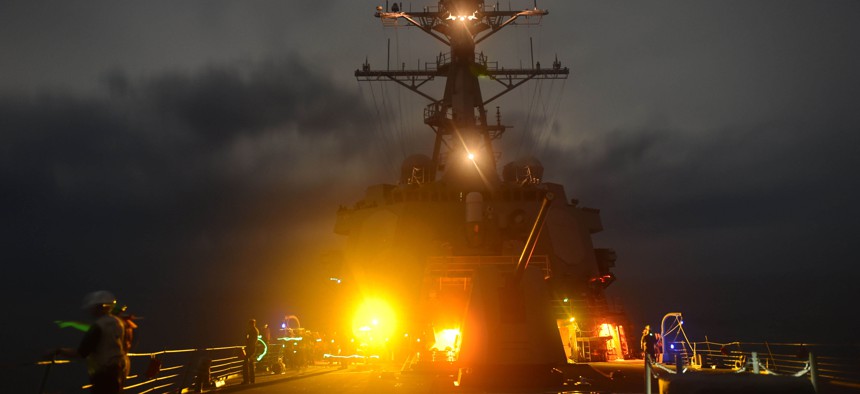
The Arleigh Burke-class guided-missile destroyer USS Lassen (DDG 82) patrols the South China Sea, Sep. 28, 2015. U.S. Navy photo by Mass Communication Specialist 2nd Class Corey T. Jones/Released
China is Cruising for a Bruising
The U.S. Navy must get ready for big new Chinese ships that will try to ram Americans who approach their fake islands.
China is attempting to create a situation wherein the United States, to uphold international law, will either have to accede to their territorial claims in the South China Sea or openly resort to the use of hostile force, allowing China to publicly portray the U.S. as an imperialist aggressor state. Beijing is betting that the United States will not take this action and that power over the South China Sea and all the resources that lie beneath will pass to China, breaking American influence in the region.
The United States must anticipate Beijing's next move, get inside its decision loop, and reveal China as the aggressive, would-be hegemon that it is.
We’ve been here before. In 1996, the U.S. sailed two aircraft carriers near Taiwan, which led China to develop the DF-21 carrier-killer anti-ship ballistic missile. Now President Barack Obama’s decision to sail American warships near China’s artificially created and disputed islands in the South China Sea has triggered another sophisticated response. China has announced its intention to build a massive new coast guard ship ostensibly to patrol its territorial waters, protect its fisheries, and uphold its laws. This is a huge ship and its physical characteristics fall far outside the norms associated with the coast guard mission. For instance, the U.S. Coast Guard’s Legend-class national security cutter is 418 feet long and displaces 4,500 tons of water. The Chinese cutter will be over 500 feet long and displace more than 10,000 tons. The ship will be lightly armed, with two 76mm guns and other small arms, but these are not important to its true mission. This ship and its follow-on sister ships are built for one purpose: to move other ships out of the way.
Ramming or “shouldering” ships at sea has been a common practice throughout the modern era. During the Cold War, Russian and American ships went “skin-to-skin” more than once, often denting or damaging each other as they contested territorial claims or protested close surveillance during critical exercises. When the Soviet Union made excessive territorial sea claims in the 1980s the U.S. Navy conducted “innocent passage” exercises by sailing ships within the claimed standoffs to assert the right to operate in international waters. The Soviet Navy responded by attempting to shoulder American ships out of their claimed waters. The Americans, possessing larger ships, maintained their course and departed the waters at the time and place of their own choosing, much to the Soviets' embarrassment.
Related: Defense One's complete coverage of the South China Sea
China has gone head-to-head with other Asian powers over its claims in the South China and East China Seas. Chinese Coast Guard and Marine Surveillance vessels have threatened or shouldered other nations’ vessels throughout the region in attempt to uphold their broader territorial claims. The use of Marine Surveillance and Coast Guard vessels, painted white as distinctive “civilian law enforcement” ships, is part of a strategic communications plan to portray Chinese actions as non-aggressive law enforcement operation even as they threaten to sink and destroy vessels from other countries. Thus far China has been largely successful in their intimidation techniques, with two exceptions.
In October, the guided missile destroyer USS Lassen conducted an innocent passage exercise inside of 12 nautical miles of an artificial island constructed by China in the South China Sea to demonstrate that the United States did not recognize its illegal claims. In January, the destroyer Curtis Wilbur conducted a similar innocent passage maneuver within 12 nautical miles of Triton Island in response to China’s attempts to curtail free navigation in that area of the South China Sea. In the first instance the Chinese People’s Liberation Army Navy sortied two ships to trail, but not interfere with, the American ship. The second event seemingly took the Chinese by surprise and no vessel came out to meet the Americans, and it would not have mattered if they had. At 9,500 tons, the Lassen and the Wilbur were just too big for the Chinese navy to move, but that will not be true for much longer.
There are a set of well-established rules of the road for ships at sea, rules that delineate who is to "give way” to the other when two vessels meet in order to avoid going bump in the night. But there is also an unwritten “law of gross tonnage” that recognizes that larger ships are less maneuverable and that smaller ships should maneuver to avoid them. Physics, it seems, has a place on the world’s oceans, and China intends to take advantage of some very hard science.
It is clear that China intends to use its monster white-hulled Coast Guard ships to respond to future US freedom of navigation operations by shouldering smaller U.S. Navy vessels out of illegitimately claimed waters. Such operations would force the U.S. to either accede to Chinese demands or climb the ladder of escalation by forcibly defending themselves with arms, allowing China to play the victim of U.S. aggression. The United States should give some thought to modifying the design of the 60,000 ton afloat forward staging base ships being built in San Diego to allow them to serve as “blockers” for U.S. combatants upholding innocent passage missions. Anticipating China’s next move and providing an option that doesn’t include force will help maintain U.S. leadership and is the surest guarantee of peace in the region.




